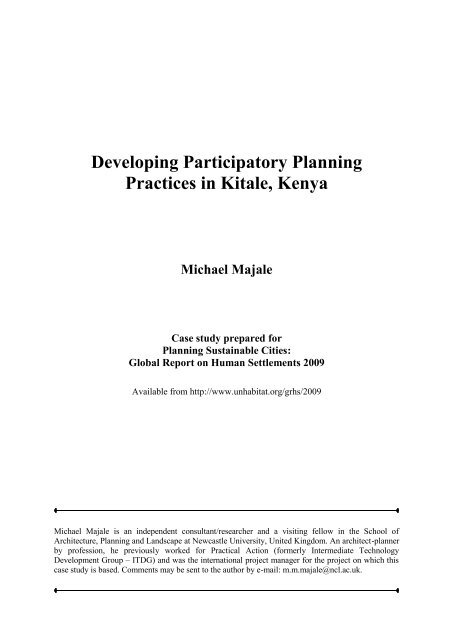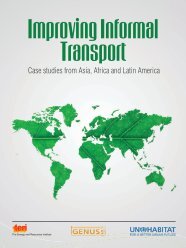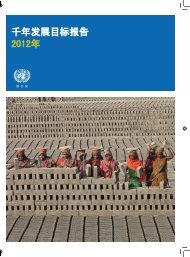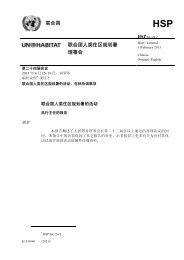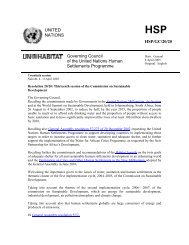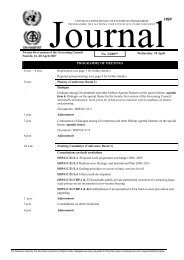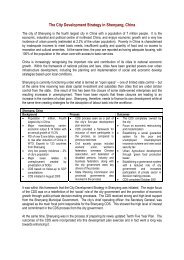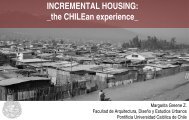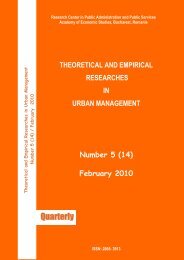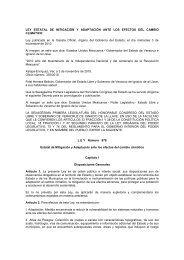Developing Participatory Planning Practices in Kitale ... - UN-Habitat
Developing Participatory Planning Practices in Kitale ... - UN-Habitat
Developing Participatory Planning Practices in Kitale ... - UN-Habitat
Create successful ePaper yourself
Turn your PDF publications into a flip-book with our unique Google optimized e-Paper software.
<strong>Develop<strong>in</strong>g</strong> <strong>Participatory</strong> <strong>Plann<strong>in</strong>g</strong><br />
<strong>Practices</strong> <strong>in</strong> <strong>Kitale</strong>, Kenya<br />
Michael Majale<br />
Case study prepared for<br />
<strong>Plann<strong>in</strong>g</strong> Susta<strong>in</strong>able Cities:<br />
Global Report on Human Settlements 2009<br />
Available from http://www.unhabitat.org/grhs/2009<br />
Michael Majale is an <strong>in</strong>dependent consultant/researcher and a visit<strong>in</strong>g fellow <strong>in</strong> the School of<br />
Architecture, <strong>Plann<strong>in</strong>g</strong> and Landscape at Newcastle University, United K<strong>in</strong>gdom. An architect-planner<br />
by profession, he previously worked for Practical Action (formerly Intermediate Technology<br />
Development Group – ITDG) and was the <strong>in</strong>ternational project manager for the project on which this<br />
case study is based. Comments may be sent to the author by e-mail: m.m.majale@ncl.ac.uk.
Disclaimer: This case study is published as submitted by the consultant, and it has not been edited by<br />
the United Nations.<br />
The designations employed and the presentation of the material <strong>in</strong> this publication do not imply the<br />
expression of any op<strong>in</strong>ion whatsoever on the part of the Secretariat of the United Nations concern<strong>in</strong>g<br />
the legal status of any country, territory, city or area, or of its authorities, or concern<strong>in</strong>g delimitation of<br />
its frontiers or boundaries, or regard<strong>in</strong>g its economic system or degree of development.<br />
The analysis, conclusions and recommendations of the report do not necessarily reflect the views of<br />
the United Nations Human Settlements Programme, the Govern<strong>in</strong>g Council of the United Nations<br />
Human Settlements Programme or its Member States.
<strong>Develop<strong>in</strong>g</strong> <strong>Participatory</strong> <strong>Plann<strong>in</strong>g</strong> <strong>Practices</strong> <strong>in</strong> <strong>Kitale</strong>, Kenya<br />
Michael Majale<br />
Introduction<br />
The world’s urban population is grow<strong>in</strong>g at a faster rate than the total population of the world.<br />
By 2030, the global urban population is projected to <strong>in</strong>crease by over 2 billion; at the same<br />
time, the rural population will stabilize and then decl<strong>in</strong>e by an estimated 20 million. More<br />
than 90 per cent of this urban population growth will be <strong>in</strong> develop<strong>in</strong>g countries, and by 2030<br />
the urban population will have far surpassed the rural population (Millennium Project, 2005;<br />
United Nations, 2004). In Africa, rural-to-urban transformation is tak<strong>in</strong>g place <strong>in</strong> a context of<br />
far higher absolute population growth, far lower levels of socio-economic development, and<br />
significantly less <strong>in</strong>stitutional capacity, at all levels, than was the case dur<strong>in</strong>g the urbanization<br />
of the now-developed world. Consequently, although Africa rema<strong>in</strong>s the least urbanized<br />
region of the world, it is where urbanization is pos<strong>in</strong>g perhaps its most difficult challenges.<br />
<strong>Develop<strong>in</strong>g</strong> country local authorities are fac<strong>in</strong>g considerable challenges <strong>in</strong> try<strong>in</strong>g to plan and<br />
manage urban development and deliver services. The problems they face are compounded by<br />
the urbanization of poverty. The most visible manifestation of this are the slums and <strong>in</strong>formal<br />
settlements <strong>in</strong> which the grow<strong>in</strong>g urban poor majority live and work, and which have<br />
developed outside formal urban plann<strong>in</strong>g and regulatory frameworks.<br />
It could be argued that the poor, who organize, plan and build slums and <strong>in</strong>formal settlements<br />
illegally, are “the most important organizers, builders and planners of [develop<strong>in</strong>g country]<br />
cities” (Hardoy and Satterthwaite, 1989:15). However, most governments do not see them as<br />
such, and many refuse to recognize them as citizens with legitimate rights. Slums and<br />
<strong>in</strong>formal settlements are, consequently, seldom supplied with <strong>in</strong>frastructure and services<br />
essential to health and well-be<strong>in</strong>g. Where they are, the provision usually takes place long after<br />
the settlement first developed. Many develop<strong>in</strong>g country cities are thus be<strong>in</strong>g built essentially<br />
‘back to front’ (Zetter, 2002:32)—with development preced<strong>in</strong>g plann<strong>in</strong>g; build<strong>in</strong>g first, and<br />
regularization of tenure and provision of <strong>in</strong>frastructure services last.<br />
If the problems posed by rapid urban growth <strong>in</strong> develop<strong>in</strong>g countries, <strong>in</strong> particular the<br />
proliferation and expansion of slums and <strong>in</strong>formal settlements, are to be effectively addressed,<br />
and susta<strong>in</strong>able urbanization achieved, there is urgent need to review the <strong>in</strong>stitutional and<br />
regulatory frameworks govern<strong>in</strong>g urban plann<strong>in</strong>g and development. In particular, the<br />
contribution of “[t]he true planners and builders...the poor” (Hardoy and Satterthwaite, 1989:<br />
back cover) to urban development must be recognized, and <strong>in</strong>stitutional and regulatory<br />
frameworks should enable their participation <strong>in</strong> plann<strong>in</strong>g, decision mak<strong>in</strong>g and<br />
implementation processes.<br />
This case study reviews a participatory action research project, ‘Build<strong>in</strong>g <strong>in</strong> Partnership:<br />
<strong>Participatory</strong> Urban <strong>Plann<strong>in</strong>g</strong>’ (BiP:PUP), implemented by the <strong>in</strong>ternational nongovernmental<br />
organisation (NGO) Intermediate Technology Development Group (ITDG) 1 <strong>in</strong><br />
<strong>Kitale</strong>, a rapidly grow<strong>in</strong>g secondary town <strong>in</strong> Kenya. 2 The project sought to address some of<br />
the above-mentioned problems, which <strong>Kitale</strong>, like many other develop<strong>in</strong>g country cities and<br />
towns, is experienc<strong>in</strong>g. The overall goal of the project was thus to enhance the effectiveness<br />
1. In July 2005, ITDG changed its name to Practical Action.<br />
2. The BiP:PUP project was implemented between April 2001 and March 2004 with fund<strong>in</strong>g from the UK<br />
Government’s Department for International Development (DFID).<br />
<strong>Develop<strong>in</strong>g</strong> <strong>Participatory</strong> <strong>Plann<strong>in</strong>g</strong><br />
Case study prepared for the<br />
<strong>Practices</strong> <strong>in</strong> <strong>Kitale</strong>, Kenya Page 3 of 16 Global Report on Human Settlements 2009
of urban plann<strong>in</strong>g and management by address<strong>in</strong>g some of the deficiencies of exist<strong>in</strong>g<br />
<strong>in</strong>stitutional and regulatory frameworks that have contributed to the growth of slums. The<br />
case study reviews what impact the NGO <strong>in</strong>terventions have had, and presents the key lessons<br />
learned <strong>in</strong> implement<strong>in</strong>g the BiP:PUP project.<br />
Table 1. Distribution of urban population <strong>in</strong> Kenya by size of urban centre, 1948–1999<br />
1948 1962 1969 1979 1989 1999<br />
No. % No. % No. % No. % No. % No. %<br />
Over 100,000 1 6 2 6 2 4 3 3 6 4 20 10<br />
20,000–99,999 1 6 2 6 2 4 13 15 21 15 82 42<br />
10,000–19,999 2 12 3 9 7 15 11 12 19 14 18 9<br />
5000–9999 3 18 11 32 11 24 22 24 32 23 23 12<br />
2000–4999 10 58 16 47 25 53 42 46 61 44 51 27<br />
Total number of<br />
urban centres<br />
Total urban pop.<br />
(millions)<br />
Total country pop.<br />
(millions)<br />
17 100 34 100 47 100 91 100 139 100 194 100<br />
0.28 0.75 1.08 2.31 3.88 9.90<br />
5.4 8.6 10.9 15.3 21.4 28.7<br />
Urban pop. as % of<br />
5.1 7.8 9.9 15.1 18.1 34.5<br />
total country pop.<br />
Source: Mano Promotion Committee 2005: 3–4.<br />
Urbanization <strong>in</strong> Kenya<br />
The process of urbanization <strong>in</strong> Kenya has accelerated s<strong>in</strong>ce <strong>in</strong>dependence from British<br />
colonial rule <strong>in</strong> 1963. As Table 1 shows, <strong>in</strong> 1962, only one <strong>in</strong> twelve people lived <strong>in</strong> an urban<br />
centre, def<strong>in</strong>ed as a gazetted settlement with a m<strong>in</strong>imum of 2000 <strong>in</strong>habitants. However, by<br />
1999, this proportion had <strong>in</strong>creased to one <strong>in</strong> three. This ratio is projected to <strong>in</strong>crease to one <strong>in</strong><br />
two by 2015.<br />
The urban population was <strong>in</strong>itially concentrated <strong>in</strong> the two largest urban centres: Nairobi, the<br />
capital city, and Mombasa, the pr<strong>in</strong>cipal port (see Figure 1). However, the past three decades<br />
have seen a decl<strong>in</strong>e <strong>in</strong> the population primacy of the two cities. In 1969, they accounted for<br />
70 per cent of the entire urban population; but their comb<strong>in</strong>ed proportionate share dropped to<br />
29 per cent <strong>in</strong> 1999. Statistical evidence also <strong>in</strong>dicates that secondary towns are grow<strong>in</strong>g at a<br />
relatively faster rate. What is important for urban plann<strong>in</strong>g is that rapid urban growth will<br />
cont<strong>in</strong>ue, pos<strong>in</strong>g significant and unprecedented challenges.<br />
Local Context: <strong>Kitale</strong> and ma<strong>in</strong> dimensions<br />
Located about 380 km to the north-west of Nairobi (see Figure 1), <strong>Kitale</strong> is the adm<strong>in</strong>istrative<br />
and commercial capital of Trans-Nzoia District. The Municipality's immediate h<strong>in</strong>terland is<br />
well-known for its historically high agricultural potential. <strong>Kitale</strong> also serves as a frontier town<br />
for the dry and drought-prone northern Kenya region.<br />
<strong>Develop<strong>in</strong>g</strong> <strong>Participatory</strong> <strong>Plann<strong>in</strong>g</strong><br />
Case study prepared for the<br />
<strong>Practices</strong> <strong>in</strong> <strong>Kitale</strong>, Kenya Page 4 of 16 Global Report on Human Settlements 2009
Figure 1: Major urban centres <strong>in</strong> Kenya<br />
<strong>Kitale</strong>’s annual population growth rate of 12 per cent is higher than the national urban average<br />
of 7 per cent. Fuelled by rural-urban migration, largely as a result of decreas<strong>in</strong>g economic<br />
opportunities <strong>in</strong> the outly<strong>in</strong>g farmlands and recurrent drought <strong>in</strong> northern Kenya, <strong>in</strong>-migration<br />
from other urban centres, and natural growth, the population upsurge has overstretched the<br />
capacity of <strong>Kitale</strong> Municipal Council to effectively plan and manage the town’s growth.<br />
Indeed, it has far outstripped the supply of planned and serviced land; <strong>in</strong>frastructure<br />
provision; formal hous<strong>in</strong>g development; and employment creation. As a result, 65 per cent of<br />
the 220,000 population live <strong>in</strong> slums and <strong>in</strong>formal settlements characterized by <strong>in</strong>secure<br />
tenure, <strong>in</strong>adequate <strong>in</strong>frastructure and social services, poor quality hous<strong>in</strong>g, overcrowd<strong>in</strong>g,<br />
unemployment and socio-economic marg<strong>in</strong>alization. They consequently face multiple threats<br />
to their health, well be<strong>in</strong>g and security; and are also largely disenfranchised with respect to<br />
participation <strong>in</strong> plann<strong>in</strong>g and decision-mak<strong>in</strong>g processes. In this respect, <strong>Kitale</strong> is similar to<br />
rapidly grow<strong>in</strong>g cities and towns throughout the develop<strong>in</strong>g world.<br />
At the time the BiP:PUP project was conceived, urban development <strong>in</strong> <strong>Kitale</strong>, as <strong>in</strong> other<br />
municipalities <strong>in</strong> Kenya, was becom<strong>in</strong>g <strong>in</strong>creas<strong>in</strong>gly unsusta<strong>in</strong>able for several reasons,<br />
<strong>in</strong>clud<strong>in</strong>g:<br />
• <strong>in</strong>effective urban plann<strong>in</strong>g methods and <strong>in</strong>adequate development control;<br />
• poor standards of urban <strong>in</strong>frastructure and services;<br />
• poor ma<strong>in</strong>tenance of council assets, <strong>in</strong>clud<strong>in</strong>g rental hous<strong>in</strong>g;<br />
• <strong>in</strong>adequate revenue collection for services; and<br />
• lack of community participation <strong>in</strong> urban plann<strong>in</strong>g and management.<br />
Furthermore, slums and <strong>in</strong>formal settlements were lowest on the Council’s list of priority<br />
<strong>in</strong>vestment areas. Those <strong>in</strong> the <strong>in</strong>ner areas of the town are on public land, and <strong>in</strong>habitants<br />
either have no security of tenure or may have letters of allotment issued by the Council. Those<br />
<strong>Develop<strong>in</strong>g</strong> <strong>Participatory</strong> <strong>Plann<strong>in</strong>g</strong><br />
Case study prepared for the<br />
<strong>Practices</strong> <strong>in</strong> <strong>Kitale</strong>, Kenya Page 5 of 16 Global Report on Human Settlements 2009
<strong>in</strong> the peri-urban areas have developed on farms which were bought from white settlers by<br />
land-buy<strong>in</strong>g companies and co-operatives and then subdivided <strong>in</strong>to smaller plots and<br />
distributed among shareholders and members. They are thus located on land which was until<br />
recently classified as agricultural, but is now urban follow<strong>in</strong>g municipal boundary expansion.<br />
Consequently, they present a significant challenge not only for urban plann<strong>in</strong>g and<br />
development control, but also for service delivery, which is made more problematic because<br />
the plot owners do not pay rates to the Council which could help f<strong>in</strong>ance <strong>in</strong>frastructure<br />
development. Furthermore, they are not <strong>in</strong>cluded <strong>in</strong> the outdated master plan.<br />
The Council was unable to oversee urban development largely because of lack of local-level<br />
<strong>in</strong>stitutional capacity <strong>in</strong> urban plann<strong>in</strong>g and management, <strong>in</strong>clud<strong>in</strong>g the absence of a<br />
municipal planner. Institutional <strong>in</strong>stability caused by frequent changes <strong>in</strong> the offices of mayor<br />
and town clerk also underm<strong>in</strong>ed good governance.<br />
The Local Governance System <strong>in</strong> Kenya: An Overview<br />
The structure of local government <strong>in</strong> Kenya (Figure 2) has its roots <strong>in</strong> the Local Government<br />
Regulations of 1963, which underwent several amendments before be<strong>in</strong>g converted <strong>in</strong>to the<br />
Local Government Act, Cap 265 of the laws of Kenya <strong>in</strong> 1978. The Act dist<strong>in</strong>guishes four<br />
types of local authorities:<br />
• Municipal councils;<br />
• Town councils;<br />
• County councils; and<br />
• Urban councils.<br />
Under the Local Government Act, and over 30 other statutes, the M<strong>in</strong>istry of Local<br />
Government facilitates the operations of all 175 local authorities. Specifically, its mission is:<br />
“[t]o facilitate Local Authorities to achieve good governance and improved service delivery<br />
for enhanced socio-economic development” (Republic of Kenya, 2005:25).<br />
The Local Government Act places significant responsibilities on local authorities, but also<br />
provides for legal, adm<strong>in</strong>istrative and regulatory powers on the basis of decentralised<br />
authority. Under the Act, local authorities have responsibility for, among other th<strong>in</strong>gs, land<br />
use plann<strong>in</strong>g and delivery of <strong>in</strong>frastructure and social services. They are also responsible for<br />
oversee<strong>in</strong>g urban development, which is governed by various legislative acts, the ma<strong>in</strong> ones<br />
of which are listed <strong>in</strong> Box 1. However, they have neither the capacity nor the resources to<br />
carry out many of their functions and responsibilities.<br />
M<strong>in</strong>istry of Local Government<br />
City Councils<br />
Municipal and Town Councils<br />
County Councils<br />
Urban and Area Councils<br />
Figure 2: Structure of Local Government<br />
<strong>Develop<strong>in</strong>g</strong> <strong>Participatory</strong> <strong>Plann<strong>in</strong>g</strong><br />
Case study prepared for the<br />
<strong>Practices</strong> <strong>in</strong> <strong>Kitale</strong>, Kenya Page 6 of 16 Global Report on Human Settlements 2009
Box 1: Legislation govern<strong>in</strong>g urban development<br />
The ma<strong>in</strong> legislation govern<strong>in</strong>g urban development <strong>in</strong>cludes the Constitution of Kenya, 1969 (as<br />
amended to 1997); the Land Titles Act, Cap 282 (1908); the Government Lands Act, Cap 280<br />
(1915, revised <strong>in</strong>. 1984); the Registration of Titles Act, Cap 281 (1919); the Land Acquisition<br />
Act, Cap 295 (1983); the Valuation of Rat<strong>in</strong>g Act, Cap 266 (1956); the Rat<strong>in</strong>g Act, Cap 267<br />
(1963); the Hous<strong>in</strong>g Act, Cap 117 (1953); the Rent Restriction Act, Cap 296, 1959; the Landlord<br />
and Tenant (Shops, Hotels and Cater<strong>in</strong>g Establishments) Act Cap 301, 1965; the Physical<br />
<strong>Plann<strong>in</strong>g</strong> Act, Cap. 286, 1996; the Local Government Act, Cap 265, 1998; the Environmental<br />
Management and Coord<strong>in</strong>ation Act, 1999.<br />
Kenya’s rapid rate of urbanization has also eroded the efficiency of “traditional plann<strong>in</strong>g<br />
approaches” (Watson, 2007:16), such as master plans. The problem has been compounded by<br />
the phenomenon of ‘land grabb<strong>in</strong>g’—“privatization of public land through wanton and illegal<br />
allocation of such land to private <strong>in</strong>dividuals and corporations <strong>in</strong> total disregard of the public<br />
<strong>in</strong>terest” (M<strong>in</strong>istry of Lands, 2006:8). As the report of a Commission of Inquiry <strong>in</strong>to the<br />
Illegal / Irregular Allocation of Public Land affirms, dur<strong>in</strong>g the late 1980s and throughout the<br />
1990s, “‘land grabb<strong>in</strong>g’ became part and parcel of official grand corruption...” (Government<br />
of Kenya, 2004:8).<br />
Thus, like many other countries, Kenya has been reform<strong>in</strong>g its system of local government<br />
with the aim of strengthen<strong>in</strong>g the capacity of local authorities to effectively fulfil their<br />
responsibilities, particularly <strong>in</strong> regard to urban plann<strong>in</strong>g, management and service delivery,<br />
and improv<strong>in</strong>g urban governance.<br />
Kenya Local Government Reform Programme<br />
The Kenya Local Government Reform Programme, started <strong>in</strong> 1996, aims to strengthen and<br />
expand the capacities and revenue base of local authorities through legal, f<strong>in</strong>ancial<br />
management and <strong>in</strong>stitutional reforms; and by improv<strong>in</strong>g operational relationships between<br />
central and local government, and between local authorities, local communities and the<br />
private sector. A key element of the Programme is the Local Authority Transfer Fund, which<br />
provides 5 per cent of national <strong>in</strong>come tax to local authorities <strong>in</strong> l<strong>in</strong>e with population, resource<br />
base and f<strong>in</strong>ancial performance. 3 Local Authority Transfer Fund conditions require local<br />
authorities to prepare Local Authority Service Delivery Plans. A structured annual cycle of<br />
participatory plann<strong>in</strong>g and budget<strong>in</strong>g, the preparation of these plans aims to <strong>in</strong>form the<br />
strategic prioritisation of municipal allocations from central government and provide an<br />
<strong>in</strong>stitutional framework for pro-poor spend<strong>in</strong>g on <strong>in</strong>frastructure and services. It is also<br />
<strong>in</strong>tended to provide the l<strong>in</strong>k between plann<strong>in</strong>g and budget<strong>in</strong>g, which is essential if plans are to<br />
be implemented (Watson, 2007). Local Authority Service Delivery Plans also seek to create<br />
partnerships by match<strong>in</strong>g this budget with other government, private sector and development<br />
partner resources. This approach builds on a strong tradition of widespread community<br />
participation <strong>in</strong> mobiliz<strong>in</strong>g and support<strong>in</strong>g fund<strong>in</strong>g and development of public facilities, such<br />
3. The Government of Kenya has put <strong>in</strong> place a decentralized system for fund<strong>in</strong>g local level development<br />
projects. Such fund<strong>in</strong>g mechanisms <strong>in</strong>clude the Local Authority Transfer Fund, the Constituency Development<br />
Fund, the Constituency/District HIV/AIDS Fund and the Poverty Eradication Fund. The Constituency<br />
Development Fund was established by an Act of Parliament <strong>in</strong> 2003 and is divided equally among all the<br />
constituencies, with a small weight<strong>in</strong>g <strong>in</strong> favour of the poorer ones (NCCK, 2005). The devolvement of the<br />
Constituency Development Fund is <strong>in</strong>tended to ensure that local communities can participate both <strong>in</strong> the<br />
prioritisation of projects to be funded, and <strong>in</strong> monitor<strong>in</strong>g the expenditure (KHRC, 2006).<br />
<strong>Develop<strong>in</strong>g</strong> <strong>Participatory</strong> <strong>Plann<strong>in</strong>g</strong><br />
Case study prepared for the<br />
<strong>Practices</strong> <strong>in</strong> <strong>Kitale</strong>, Kenya Page 7 of 16 Global Report on Human Settlements 2009
as educational and health facilities, promoted s<strong>in</strong>ce <strong>in</strong>dependence, called ‘harambee’ (Lyons<br />
et al., 2006).<br />
The Physical <strong>Plann<strong>in</strong>g</strong> Act (Cap 286 of 1996)<br />
Another important action on the part of Government to address the challenges of urban<br />
plann<strong>in</strong>g and development was the pass<strong>in</strong>g of the Physical <strong>Plann<strong>in</strong>g</strong> Act (Cap 286 of 1996)<br />
and the Physical Planners Registration Act (No. 3 of 1996). The former repealed the Land<br />
<strong>Plann<strong>in</strong>g</strong> Act and Town <strong>Plann<strong>in</strong>g</strong> Acts, which were a colonial heritage, and was <strong>in</strong>tended to:<br />
• harmonize plann<strong>in</strong>g procedures and requirements provided for <strong>in</strong> other pieces of<br />
legislation;<br />
• provide an effective <strong>in</strong>stitutional framework to regulate plann<strong>in</strong>g practice;<br />
• provide a framework for public participation <strong>in</strong> plann<strong>in</strong>g and plan implementation; and<br />
• provide a legal framework to protect public land <strong>in</strong>tended for public amenities and<br />
utilities from misappropriation (Ogero, 2004).<br />
Under the Physical <strong>Plann<strong>in</strong>g</strong> Act, overall responsibility for national, regional and local<br />
physical development policies, guidel<strong>in</strong>es and strategies, and preparation of all regional and<br />
local physical development plans, lies with the Director of Physical <strong>Plann<strong>in</strong>g</strong>, who heads the<br />
Department of Physical <strong>Plann<strong>in</strong>g</strong> <strong>in</strong> the M<strong>in</strong>istry of Lands and Settlement. The key role of the<br />
Department of Physical <strong>Plann<strong>in</strong>g</strong> is the production of physical development plans, and it is<br />
represented at prov<strong>in</strong>cial and district levels. There is a Prov<strong>in</strong>cial Physical <strong>Plann<strong>in</strong>g</strong> Officer <strong>in</strong><br />
each of the eight prov<strong>in</strong>ces, but only 47 of the 149 districts <strong>in</strong> the country currently have<br />
physical plann<strong>in</strong>g offices, staffed with one or two tra<strong>in</strong>ed planners. The Department of<br />
Physical <strong>Plann<strong>in</strong>g</strong> works closely with local authorities <strong>in</strong> matters related to physical plann<strong>in</strong>g<br />
with<strong>in</strong> municipal boundaries. At the same time, the Urban Development Department <strong>in</strong> the<br />
M<strong>in</strong>istry of Local Government also gives guidance and provides technical assistance to local<br />
authorities, and liaises with them to formulate and implement urban development policies and<br />
growth strategies. However, <strong>in</strong>stitutional capacity at the local authority level is also a<br />
problem. At the time the BiP:PUP project was implemented, only four local authorities<br />
(Nairobi, Mombasa, Kisumu and Thika) had staffed plann<strong>in</strong>g units; and, to date, still only 16<br />
of the 175 local authorities have a tra<strong>in</strong>ed planner—amongst them <strong>Kitale</strong>. Most local<br />
authorities are consequently unable to exercise the powers conferred on, and perform the<br />
functions assigned to, them under the Physical <strong>Plann<strong>in</strong>g</strong> Act.<br />
Kenya Rapid Urban Sector Profile<br />
The Kenya Urban Sector Study identifies poor governance as “the key issue that has led to<br />
poverty and weak <strong>in</strong>stitutional responses <strong>in</strong> all aspects of the urban sector” (<strong>UN</strong>-HABITAT,<br />
2005:8). It blames weak <strong>in</strong>stitutions, a highly centralized system constra<strong>in</strong>ed by bureaucracy,<br />
and lack of local accountability.<br />
Governance problems related to the <strong>in</strong>stitutional framework <strong>in</strong>clude the follow<strong>in</strong>g:<br />
• Local governments are weakened and constra<strong>in</strong>ed by strong central government<br />
adm<strong>in</strong>istrative and f<strong>in</strong>ancial control.<br />
• The M<strong>in</strong>istry of Local Government supervises and resources all local authorities as<br />
powers, resources and revenue rais<strong>in</strong>g capacity have not been fully devolved to the<br />
local level.<br />
• Service delivery by local authorities is constra<strong>in</strong>ed by <strong>in</strong>adequate resources, weak<br />
adm<strong>in</strong>istrative capacity and political <strong>in</strong>terference.<br />
<strong>Develop<strong>in</strong>g</strong> <strong>Participatory</strong> <strong>Plann<strong>in</strong>g</strong><br />
Case study prepared for the<br />
<strong>Practices</strong> <strong>in</strong> <strong>Kitale</strong>, Kenya Page 8 of 16 Global Report on Human Settlements 2009
• Urban services, <strong>in</strong> the absence of strategic plans, lack coherent plann<strong>in</strong>g, which limits<br />
implementation and monitor<strong>in</strong>g of projects.<br />
• Non-comprehensive plann<strong>in</strong>g leads to <strong>in</strong>adequate allocation of resources and erratic<br />
implementation of development <strong>in</strong>terventions.<br />
• Opportunities for partnerships between the public, private and civil society sectors<br />
have been underexploited (<strong>UN</strong>-HABITAT, 2005).<br />
As regards the regulatory framework:<br />
• Local by-laws proposed by local governments must be approved by the M<strong>in</strong>istry of<br />
Local Government and then passed by parliament.<br />
• The Physical <strong>Plann<strong>in</strong>g</strong> Act gives local authorities plann<strong>in</strong>g responsibilities, but few<br />
have tra<strong>in</strong>ed planners and must refer issues to the central government Physical<br />
<strong>Plann<strong>in</strong>g</strong> Department.<br />
• The Local Authority Service Development Action Plan process, which enabled wardlevel<br />
participatory decision-mak<strong>in</strong>g and budget<strong>in</strong>g, is not effectively implemented as<br />
“it is little understood by municipalities and citizens” (<strong>UN</strong>-HABITAT, 2005:8).<br />
The above problems were all be<strong>in</strong>g experienced <strong>in</strong> <strong>Kitale</strong> when ITDG conceived the BiP:PUP<br />
project.<br />
The Build<strong>in</strong>g <strong>in</strong> Partnership: <strong>Participatory</strong> Urban <strong>Plann<strong>in</strong>g</strong> (BiP:PUP)<br />
project<br />
The overall goal of the BiP:PUP project was “to enhance the effectiveness of city and<br />
municipal plann<strong>in</strong>g and management”; more specifically, the project purpose was “to test,<br />
develop and dissem<strong>in</strong>ate a partnership approach to the plann<strong>in</strong>g of urban space with [local<br />
<strong>in</strong>stitutions]”.<br />
The BiP:PUP project brought together three methodologies: participatory plann<strong>in</strong>g,<br />
partnership and local development. The aim was to achieve locally appropriate development<br />
which is economically, socially and environmentally susta<strong>in</strong>able; and a momentum and<br />
<strong>in</strong>stitutional framework for plann<strong>in</strong>g and urban development that will cont<strong>in</strong>ue to function <strong>in</strong><br />
the long term. The project also <strong>in</strong>cluded fund<strong>in</strong>g for the construction of small-scale<br />
demonstration projects. It thus provided an ideal opportunity to operationalize the pr<strong>in</strong>ciples<br />
of the Kenya Local Government Reform Programme and the Local Authority Service<br />
Development Action Plan process, as well as the provisions of the Physical <strong>Plann<strong>in</strong>g</strong> Act.<br />
The first partnership formed under the BiP:PUP project was between <strong>Kitale</strong> Municipal<br />
Council and ITDG. A most important element of the partnership agreement was that the<br />
former would provide the latter with space for the project office <strong>in</strong> the Town Hall. As the<br />
office was close to the Mayor’s Parlour, it proved <strong>in</strong>valuable <strong>in</strong> help<strong>in</strong>g secure the back<strong>in</strong>g of<br />
the Mayor and <strong>in</strong> galvaniz<strong>in</strong>g much needed political will and support among local councillors.<br />
In addition to the local communities, two other key partners were the University of Nairobi’s<br />
Department for Urban and Regional <strong>Plann<strong>in</strong>g</strong> and the Kenya Institute of Planners. L<strong>in</strong>ks to<br />
the Association of Local Government Authorities of Kenya and the Municipal Development<br />
Programme – Eastern and Southern Africa were <strong>in</strong>tended to enable project experience and<br />
policy issues to be shared and discussed nationally, regionally and <strong>in</strong>ternationally.<br />
<strong>Develop<strong>in</strong>g</strong> <strong>Participatory</strong> <strong>Plann<strong>in</strong>g</strong><br />
Case study prepared for the<br />
<strong>Practices</strong> <strong>in</strong> <strong>Kitale</strong>, Kenya Page 9 of 16 Global Report on Human Settlements 2009
The participatory plann<strong>in</strong>g methodology adopted <strong>in</strong> <strong>Kitale</strong><br />
The BiP:PUP project followed the methodology outl<strong>in</strong>ed <strong>in</strong> Figure 3, with the aim of<br />
improv<strong>in</strong>g urban plann<strong>in</strong>g <strong>in</strong> the municipality, and provid<strong>in</strong>g efficient and cost effective<br />
services, lead<strong>in</strong>g to more equitable and susta<strong>in</strong>able development of the town.<br />
• Municipal-wide ‘scan’ survey: This was carried out to identify the needs and<br />
concerns of townspeople with respect to access to land, <strong>in</strong>frastructure and hous<strong>in</strong>g;<br />
social services and amenities; fund<strong>in</strong>g for development <strong>in</strong>terventions; and governance,<br />
<strong>in</strong> particular, corruption. The survey <strong>in</strong>cluded a participatory <strong>in</strong>ventory which<br />
identified formal and <strong>in</strong>formal local <strong>in</strong>stitutions, such as NGOs, community-based<br />
organizations, churches and private sector bus<strong>in</strong>esses (<strong>in</strong>clud<strong>in</strong>g micro, small and<br />
medium-size enterprises and professional practices). A number subsequently<br />
participated <strong>in</strong> the plann<strong>in</strong>g process and implementation of development <strong>in</strong>terventions.<br />
• Ward and settlement selection process: Follow<strong>in</strong>g an <strong>in</strong>clusive consultative rank<strong>in</strong>g<br />
process, based on the results of the surveys conducted <strong>in</strong> the 12 wards, a consensus<br />
was reached among the residents on the priority development needs by ward. This led<br />
to the selection of three <strong>in</strong>formal settlements—Kipsongo, Shimo la Tewa and<br />
Tuwan—as pilot sites to develop and test <strong>in</strong>novative <strong>in</strong>stitutional frameworks that<br />
encourage stakeholder participation and partnerships <strong>in</strong> assess<strong>in</strong>g slum communities’<br />
needs and concerns, and develop<strong>in</strong>g and implement<strong>in</strong>g susta<strong>in</strong>able upgrad<strong>in</strong>g<br />
<strong>in</strong>terventions.<br />
• Action plann<strong>in</strong>g 4 and participatory development of neighbourhood plans: Us<strong>in</strong>g<br />
the survey f<strong>in</strong>d<strong>in</strong>gs, and <strong>in</strong>formed by a literature and practice review and case studies,<br />
participatory neighbourhood plann<strong>in</strong>g exercises were carried out. This process enabled<br />
re-evaluation and focus<strong>in</strong>g of development priorities, and guided the solutions to water<br />
supply and sanitation needs and other <strong>in</strong>frastructure priorities. It culm<strong>in</strong>ated <strong>in</strong> the<br />
preparation of actionable plans by local communities <strong>in</strong> the three settlements. The<br />
follow<strong>in</strong>g were also agreed: roles and contributions of partners and capacity-build<strong>in</strong>g<br />
requirements; <strong>in</strong>stitutional arrangements for implementation; and locally appropriate<br />
methods of implementation.<br />
Municipal-wide scan survey<br />
and participatory <strong>in</strong>ventory<br />
of local <strong>in</strong>stitutions<br />
Implementation of<br />
<strong>in</strong>frastructure <strong>in</strong>terventions<br />
through participatory<br />
<strong>in</strong>stitutional arrangements<br />
Action plann<strong>in</strong>g and<br />
participatory development<br />
of neighbourhood plans<br />
<strong>Participatory</strong> identification<br />
of ward/neighbourhood<br />
development needs<br />
<strong>Participatory</strong><br />
needs analysis<br />
Consultations with<br />
local <strong>in</strong>stitutions and<br />
prioritization of needs<br />
Figure 3: The participatory urban plann<strong>in</strong>g methodology <strong>in</strong> <strong>Kitale</strong><br />
Source: After http://www.kitale.org/pup.htm<br />
4. The action plann<strong>in</strong>g process was adapted from Action <strong>Plann<strong>in</strong>g</strong> for Cities (Hamdi and Goethert, 1997), The<br />
Community <strong>Plann<strong>in</strong>g</strong> Handbook (Wates, 2000), and the ward-focused plann<strong>in</strong>g process used <strong>in</strong> Mangaung<br />
Municipality <strong>in</strong> South Africa (Ward 2 Ward Committee, 2001).<br />
<strong>Develop<strong>in</strong>g</strong> <strong>Participatory</strong> <strong>Plann<strong>in</strong>g</strong><br />
Case study prepared for the<br />
<strong>Practices</strong> <strong>in</strong> <strong>Kitale</strong>, Kenya Page 10 of 16 Global Report on Human Settlements 2009
<strong>Participatory</strong> plann<strong>in</strong>g and partnership <strong>in</strong>terventions <strong>in</strong> the three<br />
settlements<br />
The ma<strong>in</strong> achievements through participatory plann<strong>in</strong>g and partnership work<strong>in</strong>g <strong>in</strong> each of the<br />
settlements are summarized below. The approach represented a move away from the<br />
traditional ‘top-down’ <strong>in</strong>stitutional framework to a more ‘bottom-up’ and ‘lateral’ approach <strong>in</strong><br />
both the plann<strong>in</strong>g and implementation of prioritized <strong>in</strong>terventions.<br />
Kipsongo<br />
The residents of Kipsongo are primarily members of the traditionally pastoralist Turkana tribe<br />
who migrated to <strong>Kitale</strong> from Northern Kenya to escape perennial drought, conflicts over<br />
contested graz<strong>in</strong>g lands and cattle rustl<strong>in</strong>g. They are amongst the poorest and most vulnerable<br />
groups <strong>in</strong> the town, and do not have security of tenure for the land they occupy, which is<br />
owned by the Council. Through a community-driven participatory plann<strong>in</strong>g process, with<br />
support from ITDG and <strong>Kitale</strong> Municipal Council, the residents prepared a strategic action<br />
plan that prioritized water and sanitation <strong>in</strong>terventions and <strong>in</strong>cluded future growth options<br />
(such as a women’s community centre, a health cl<strong>in</strong>ic and police post). This marg<strong>in</strong>alized<br />
community was thus given a ‘voice’ <strong>in</strong> the <strong>in</strong>stitutional framework for urban plann<strong>in</strong>g and<br />
decision-mak<strong>in</strong>g for the first time. Most elements of the plan, particularly the water supply<br />
and sanitation components, have been implemented through the jo<strong>in</strong>t efforts of community<br />
based organizations, ITDG and the Council—another first, as the latter had previously never<br />
<strong>in</strong>volved itself <strong>in</strong> service provision <strong>in</strong> the settlement. Rather than <strong>in</strong>sist<strong>in</strong>g on piped water<br />
supply and water-borne sanitation, the Council relaxed the regulatory framework and allowed<br />
the use of more appropriate and affordable technologies. Protected spr<strong>in</strong>gs and ventilated<br />
improved pit latr<strong>in</strong>es were, therefore, provided at a fraction of the cost of conventional piped<br />
water and sewerage systems. Kipsongo is now <strong>in</strong>cluded <strong>in</strong> municipal plann<strong>in</strong>g processes, and<br />
the provision of health services has been agreed upon <strong>in</strong> pr<strong>in</strong>ciple. A significant unexpected<br />
outcome is that the issue of the residents’ security of tenure is be<strong>in</strong>g addressed.<br />
Shimo la Tewa<br />
Shimo la Tewa is located adjacent to an upmarket suburb, on land for which the Council has<br />
issued letters of allotment. A small, heavily polluted river separates the affluent homes from<br />
the densely populated slum. The development of a slum with<strong>in</strong> such close proximity to a<br />
wealthy neighbourhood is not uncommon <strong>in</strong> develop<strong>in</strong>g country cities, and is one of the many<br />
challenges fac<strong>in</strong>g urban plann<strong>in</strong>g. Prior to the BiP:PUP project, some 3500 people, mostly<br />
tenants, lived <strong>in</strong> poor-quality hous<strong>in</strong>g, with <strong>in</strong>adequate access to clean water supply and<br />
sanitation, and poor pedestrian accessibility and l<strong>in</strong>kages.<br />
The action plann<strong>in</strong>g process <strong>in</strong> Shimo la Tewa prioritized construction of a 130 metre span<br />
footbridge across a rav<strong>in</strong>e that divided the settlement caus<strong>in</strong>g pedestrian safety, accessibility<br />
and connectivity problems, especially dur<strong>in</strong>g heavy ra<strong>in</strong>s (See Figure 4). The footbridge was<br />
built though a partnership effort <strong>in</strong>volv<strong>in</strong>g public, private, and community <strong>in</strong>stitutions. A team<br />
compris<strong>in</strong>g the Municipal Eng<strong>in</strong>eer, a government eng<strong>in</strong>eer, and a private sector eng<strong>in</strong>eer<br />
who did not charge for his services, designed the footbridge and supervised construction. The<br />
local community, <strong>in</strong>clud<strong>in</strong>g youth groups, contributed timber for the deck<strong>in</strong>g and ‘sweat<br />
equity’, <strong>in</strong> the form of voluntary labour, both skilled and unskilled, <strong>in</strong> the spirit of<br />
‘harambee’. A local private enterprise supplied other build<strong>in</strong>g materials at reduced cost. The<br />
Council covered 30 per cent of the monetary cost of the footbridge from the Local Authority<br />
Transfer Fund and BiP:PUP project funds the rema<strong>in</strong>der. Ma<strong>in</strong>tenance of the footbridge is the<br />
<strong>Develop<strong>in</strong>g</strong> <strong>Participatory</strong> <strong>Plann<strong>in</strong>g</strong><br />
Case study prepared for the<br />
<strong>Practices</strong> <strong>in</strong> <strong>Kitale</strong>, Kenya Page 11 of 16 Global Report on Human Settlements 2009
Figure 4: The footbridge constructed <strong>in</strong> Shimo la Tewa<br />
Before<br />
After<br />
shared responsibility of community-based organizations and the Council, with the latter<br />
agree<strong>in</strong>g to meet some f<strong>in</strong>ancial costs. The <strong>in</strong>stitutional framework for plann<strong>in</strong>g and<br />
implementation adopted <strong>in</strong> Shimo la Tewa demonstrates how the Local Authority Service<br />
Development Action Plan process can be fully operationalized, and can well be replicated<br />
more widely.<br />
Tuwan<br />
With 5000 plots and an estimated 100,000 residents, most of whom are tenants, Tuwan is the<br />
largest, and somewhat most prosperous, of the three settlements. It is also the most populous<br />
slum <strong>in</strong> <strong>Kitale</strong>, hav<strong>in</strong>g developed on an extensively subdivided former colonial large-scale<br />
farm bought by a land-buy<strong>in</strong>g company. When land is converted from one use to another,<br />
there is often a need for <strong>in</strong>frastructure services; hence, the priority needs identified through<br />
the participatory process <strong>in</strong>cluded improved access to water supply and sanitation. The<br />
residents chose to address these needs through the construction of a communal ablution block,<br />
compris<strong>in</strong>g water-borne latr<strong>in</strong>es, showers with provision for hot water, laundry facilities and a<br />
multi-purpose room. <strong>Kitale</strong> Municipal Council ensured availability of the site, which was key<br />
as <strong>in</strong>formal settlements have often been the target of land grabb<strong>in</strong>g. The local community<br />
participated <strong>in</strong> design cl<strong>in</strong>ics conducted by ITDG, and attended by the local Councillor,<br />
through which the design of the facility was generated. Community-based organizations,<br />
especially women’s groups, were tra<strong>in</strong>ed and produced some of the build<strong>in</strong>g materials on site,<br />
aga<strong>in</strong> <strong>in</strong> the spirit of ‘harambee’. An <strong>in</strong>novative <strong>in</strong>stitutional structure for operation and<br />
ma<strong>in</strong>tenance of the facility was established, which <strong>in</strong>cludes a locally appo<strong>in</strong>ted committee and<br />
the Council. M<strong>in</strong>imal user charges are levied to defray operation and ma<strong>in</strong>tenance costs.<br />
Conclusions<br />
NGOs have won a grow<strong>in</strong>g reputation for their work over the past few years. However, many<br />
NGO <strong>in</strong>itiatives “tend to be good but limited <strong>in</strong> scope” and their “impact...on the lives of poor<br />
people...highly localized and often transitory” (Edwards and Hulme, 2002:53). One of the<br />
ma<strong>in</strong> reasons for this is the failure of NGOs to make the right l<strong>in</strong>kages between their work at<br />
<strong>Develop<strong>in</strong>g</strong> <strong>Participatory</strong> <strong>Plann<strong>in</strong>g</strong><br />
Case study prepared for the<br />
<strong>Practices</strong> <strong>in</strong> <strong>Kitale</strong>, Kenya Page 12 of 16 Global Report on Human Settlements 2009
the micro-level and wider structures and systems. To overcome this shortcom<strong>in</strong>g, <strong>in</strong><br />
implement<strong>in</strong>g the BiP:PUP project, ITDG adopted the multiplicative strategy, <strong>in</strong> which NGOs<br />
achieve impact through deliberate <strong>in</strong>fluence, network<strong>in</strong>g, tra<strong>in</strong><strong>in</strong>g and policy reform (Edwards<br />
and Hulme, 2002). Hence, it engaged with <strong>Kitale</strong> Municipal Council, the Physical <strong>Plann<strong>in</strong>g</strong><br />
Department, the Association of Local Government Authorities of Kenya, the Kenya Institute<br />
of Planners and the University if Nairobi’s Department for Urban and Regional <strong>Plann<strong>in</strong>g</strong>.<br />
L<strong>in</strong>kages were also made with the on-go<strong>in</strong>g Kenya Local Government Reform Programme<br />
(KLGRP) and the Local Authority Service Development Action Plan (LASDAP) process. The<br />
NGO <strong>in</strong>terventions through the BiP:PUP project have consequently had a significant impact<br />
on the <strong>in</strong>stitutional and regulatory framework for urban plann<strong>in</strong>g and <strong>in</strong>frastructure service<br />
provision <strong>in</strong> <strong>Kitale</strong>; and they have also <strong>in</strong>fluenced plann<strong>in</strong>g practice more widely nationally,<br />
as summarized below.<br />
Influence of the BiP:PUP project on urban plann<strong>in</strong>g practice <strong>in</strong> <strong>Kitale</strong> and more widely<br />
nationally 5<br />
• The BiP:PUP project helped create a broad-based participatory <strong>in</strong>stitutional framework<br />
for urban plann<strong>in</strong>g <strong>in</strong> <strong>Kitale</strong>, thereby giv<strong>in</strong>g the urban poor a voice <strong>in</strong> decision-mak<strong>in</strong>g<br />
processes. The dialogue between local communities and <strong>Kitale</strong> Municipal Council<br />
which the project <strong>in</strong>itiated is cont<strong>in</strong>u<strong>in</strong>g, <strong>in</strong> particular through the Strategic Ward<br />
Development Plan process, which emphasises the active participation of local residents<br />
<strong>in</strong> the plann<strong>in</strong>g process so as to ensure that their needs are addressed. The process also<br />
aims to enhance the effective use of decentralised funds such as the Local Authority<br />
Transfer Fund and Constituency Development Fund.<br />
• The BiP:PUP project developed and tested various generic neighbourhood-based<br />
plann<strong>in</strong>g approaches with the <strong>in</strong>volvement of local communities which have been<br />
adopted <strong>in</strong> the Strategic Ward Development Plan process. These have been l<strong>in</strong>ked to<br />
the Local Authority Service Development Action Plan process, thereby help<strong>in</strong>g<br />
<strong>in</strong>stitutionalise participatory plann<strong>in</strong>g. The experience ga<strong>in</strong>ed <strong>in</strong> l<strong>in</strong>k<strong>in</strong>g<br />
neighbourhood plann<strong>in</strong>g to the ward and town levels through the BiP:PUP project has<br />
helped remove <strong>in</strong>stitutional barriers that previously constra<strong>in</strong>ed the use of such<br />
approaches.<br />
• The NGO <strong>in</strong>terventions have significantly <strong>in</strong>fluenced urban plann<strong>in</strong>g practice <strong>in</strong> Kenya<br />
through the strategic partnership with the University if Nairobi’s Department for<br />
Urban and Regional <strong>Plann<strong>in</strong>g</strong>, which tra<strong>in</strong>s most of the country’s urban planners. The<br />
Department now teaches the BiP:PUP approach <strong>in</strong> its urban plann<strong>in</strong>g studio module;<br />
and <strong>in</strong> 2007, it supported Ruiru Municipal Council <strong>in</strong> prepar<strong>in</strong>g its Strategic<br />
Development Plan.<br />
• A tra<strong>in</strong>ed urban planner has been posted to <strong>Kitale</strong>, which has improved the Council’s<br />
<strong>in</strong>stitutional capacity to plan and manage urban development. The appo<strong>in</strong>tment was<br />
expedited follow<strong>in</strong>g a BiP:PUP project workshop attended by the then M<strong>in</strong>ister for<br />
Lands and Settlement and the Director of Physical <strong>Plann<strong>in</strong>g</strong> (Kenya Institute of<br />
Planners, 2004).<br />
• The BiP:PUP project has shown that concern should be less with the technical<br />
standards of <strong>in</strong>frastructure services and more with the prerequisites for their efficient<br />
provision (Rakodi and Devas, 1993): good <strong>in</strong>formation as a basis for plann<strong>in</strong>g,<br />
5. The <strong>in</strong>formation presented <strong>in</strong> this section is largely based on personal communication with the Paul Chege,<br />
the BiP:PUP Project Manager <strong>in</strong> Kenya. The author would like to acknowledge his valuable <strong>in</strong>put.<br />
<strong>Develop<strong>in</strong>g</strong> <strong>Participatory</strong> <strong>Plann<strong>in</strong>g</strong><br />
Case study prepared for the<br />
<strong>Practices</strong> <strong>in</strong> <strong>Kitale</strong>, Kenya Page 13 of 16 Global Report on Human Settlements 2009
sufficient f<strong>in</strong>ancial and human resources, and appropriate <strong>in</strong>stitutional arrangements<br />
and regulatory frameworks for <strong>in</strong>stallation, operation and ma<strong>in</strong>tenance.<br />
Key lessons learned<br />
There are a number of important lessons to be learned from the implementation of the<br />
BiP:PUP project, <strong>in</strong> particular with respect to creat<strong>in</strong>g enabl<strong>in</strong>g <strong>in</strong>stitutional and regulatory<br />
frameworks for participatory urban plann<strong>in</strong>g and development, and partnership formation and<br />
work<strong>in</strong>g.<br />
• Importance of political will: Political will is needed, <strong>in</strong>itially and over time, to<br />
develop and proactively implement the <strong>in</strong>stitutional framework for participatory urban<br />
plann<strong>in</strong>g. Political commitment and support at all levels of government is essential to<br />
overcome resistance to devolution of power to local governments and communities.<br />
The BiP:PUP project has demonstrated that reform of <strong>in</strong>stitutional and regulatory<br />
frameworks for urban plann<strong>in</strong>g and development is possible if political will is<br />
mobilized.<br />
• <strong>Participatory</strong> plann<strong>in</strong>g rema<strong>in</strong>s an elusive concept to many local authorities and<br />
leaders: Local authorities often misunderstand participatory plann<strong>in</strong>g and partnership<br />
approaches to mean failure on their part to deliver services or <strong>in</strong>terference <strong>in</strong><br />
established <strong>in</strong>stitutional structures and decision-mak<strong>in</strong>g processes by ‘outsiders’. There<br />
is therefore need to raise awareness among, and build the capacity of, civic leaders and<br />
local authority staff <strong>in</strong> participatory urban plann<strong>in</strong>g and partnership work<strong>in</strong>g. NGOs<br />
can play an important role <strong>in</strong> overcom<strong>in</strong>g opposition to <strong>in</strong>stitutional and regulatory<br />
reform to this end.<br />
• Need for improved <strong>in</strong>stitutional and regulatory frameworks for participatory<br />
urban plann<strong>in</strong>g: Exist<strong>in</strong>g <strong>in</strong>stitutional and regulatory frameworks do not adequately<br />
recognize the potential contribution of civil society, and <strong>in</strong> particular slum<br />
communities, and the value their participation can add to plann<strong>in</strong>g and development<br />
processes. There is need, therefore, for <strong>in</strong>stitutional and regulatory reform to facilitate<br />
and support participation and partnership arrangements at all levels. Local<br />
governments can help create appropriate <strong>in</strong>stitutional and regulatory frameworks that<br />
will enable effective participatory urban plann<strong>in</strong>g and partnership work<strong>in</strong>g.<br />
• The development of effective plann<strong>in</strong>g tools and <strong>in</strong>stitutional frameworks through<br />
experimentation takes time: The development of effective plann<strong>in</strong>g tools and<br />
<strong>in</strong>stitutional frameworks through experimentation is a gradual process where<strong>in</strong><br />
communities and other stakeholders should be given the necessary time to learn to<br />
participate and collaborate <strong>in</strong> development <strong>in</strong>terventions. Given flexible <strong>in</strong>stitutional<br />
and regulatory frameworks which allow and susta<strong>in</strong> community participation, local<br />
authorities and communities can move towards shared decision-mak<strong>in</strong>g and project<br />
implementation. The development of such <strong>in</strong>stitutional and regulatory frameworks<br />
which strengthen partnerships among stakeholders is a key element of slum upgrad<strong>in</strong>g<br />
<strong>in</strong> a context of rapid urban growth and limited municipal resources.<br />
• The relation between local effort and formal government at all levels is<br />
important: The relationship between central and local government and communitylevel<br />
governance structures is key; and issues of legitimacy, representation and longterm<br />
viability need to be resolved. It is important to learn from the range of<br />
<strong>in</strong>stitutional arrangements with<strong>in</strong> communities, NGOs, and governments how<br />
<strong>Develop<strong>in</strong>g</strong> <strong>Participatory</strong> <strong>Plann<strong>in</strong>g</strong><br />
Case study prepared for the<br />
<strong>Practices</strong> <strong>in</strong> <strong>Kitale</strong>, Kenya Page 14 of 16 Global Report on Human Settlements 2009
participatory approaches can be <strong>in</strong>tegrated <strong>in</strong>to urban plann<strong>in</strong>g and development<br />
processes. <strong>Participatory</strong> plann<strong>in</strong>g and budget<strong>in</strong>g can <strong>in</strong>form the strategic prioritisation<br />
of municipal allocations from central government and provide an <strong>in</strong>stitutional<br />
framework for pro-poor spend<strong>in</strong>g on local development needs and priorities.<br />
Partnerships that match local/municipal resources with other government resources<br />
and also private sector and other development partner resources, can significantly<br />
improve the resource base. So, too, can widespread community participation <strong>in</strong><br />
mobiliz<strong>in</strong>g and support<strong>in</strong>g fund<strong>in</strong>g and development.<br />
• Replication and up-scal<strong>in</strong>g of NGO <strong>in</strong>itiatives: There is much that can be learned<br />
from smaller-scale NGO <strong>in</strong>itiatives that has wider relevance and application. However,<br />
scal<strong>in</strong>g up NGO <strong>in</strong>itiatives is complex, and it is critical to recognise and address the<br />
challenges <strong>in</strong>volved <strong>in</strong> the process. When plann<strong>in</strong>g scal<strong>in</strong>g-up strategies, it is important<br />
to ensure their quality and susta<strong>in</strong>ability by establish<strong>in</strong>g mechanisms for monitor<strong>in</strong>g<br />
and evaluation of the quality, susta<strong>in</strong>ability and impact of the <strong>in</strong>itiatives be<strong>in</strong>g brought<br />
to scale. Replicat<strong>in</strong>g and up-scal<strong>in</strong>g of good practice is more likely to succeed with<strong>in</strong><br />
an enabl<strong>in</strong>g <strong>in</strong>stitutional framework.<br />
References<br />
Edwards, M. and D. Hulme (2002) ‘Mak<strong>in</strong>g a difference: Scal<strong>in</strong>g-up the developmental impact of<br />
NGOs — concepts and experiences’, <strong>in</strong> M. Edwards and A. Fowler (eds) The Earthscan Reader<br />
on NGO Management, Earthscan, London, pp. 53–73<br />
Government of Kenya (2004) Report of the Commission of Inquiry <strong>in</strong>to the Illegal/Irregular<br />
Allocation of Public Land, Government of Kenya, Nairobi<br />
Hamdi, N. and R. Goethert (1997) Action <strong>Plann<strong>in</strong>g</strong> for Cities: A Guide to Community Practice, John<br />
Wiley, Chichester<br />
Hardoy, J. E. and D. Satterthwaite (1989) Squatter Citizen: Life <strong>in</strong> the Urban Third World, Earthscan,<br />
London<br />
Kenya Institute of Planners (2004) ‘Strengthen<strong>in</strong>g participatory urban plann<strong>in</strong>g <strong>in</strong> East Africa’,<br />
Planners Journal 2: 5<br />
KHRC (Kenya Human Rights Commission) (2006) ‘The 2006 Haki Index: Measur<strong>in</strong>g Public<br />
Perceptions on the State of Human Rights <strong>in</strong> Kenya and the case of the Devolved Public Funds’,<br />
KHRC, Nairobi<br />
Lyons, M., M. Majale and P. Chege (2006) ‘Creat<strong>in</strong>g Susta<strong>in</strong>able Local Economic Development<br />
Through Susta<strong>in</strong>able Partnerships: The BIP-PUP Process <strong>in</strong> <strong>Kitale</strong>, Kenya’, <strong>in</strong> E. Shragge and<br />
M. Toye (eds) Community Economic Development: Build<strong>in</strong>g for Social Change, Cape Breton<br />
University Press, Sydney, pp. 264–278<br />
Millennium Project (2005) ‘A Home <strong>in</strong> the City’. United Nations Millennium Project, Task Force on<br />
Improv<strong>in</strong>g the Lives of Slum Dwellers, Earthscan, London<br />
M<strong>in</strong>istry of Lands (2006) Draft National Land Policy, National Land Policy Secretariat Nairobi<br />
NCCK (National Council of Churches of Kenya) (2005) ‘Decentralised Funds Manual’, NCCK,<br />
Nairobi<br />
Ogero, B. (2004) ‘Land issues, plann<strong>in</strong>g pr<strong>in</strong>ciples and implementation of the Physical <strong>Plann<strong>in</strong>g</strong> Act’,<br />
Planners Journal 2: 18<br />
<strong>Develop<strong>in</strong>g</strong> <strong>Participatory</strong> <strong>Plann<strong>in</strong>g</strong><br />
Case study prepared for the<br />
<strong>Practices</strong> <strong>in</strong> <strong>Kitale</strong>, Kenya Page 15 of 16 Global Report on Human Settlements 2009
Rakodi, C. and N. Devas (1993) ‘Conclusions: assess<strong>in</strong>g the new approaches’, <strong>in</strong> N. Devas and C.<br />
Rakodi (eds) Manag<strong>in</strong>g Fast Grow<strong>in</strong>g Cities. New Approaches to Urban <strong>Plann<strong>in</strong>g</strong> and.<br />
Management <strong>in</strong> the <strong>Develop<strong>in</strong>g</strong> World, Longman Scientific & Technical, Harlow, pp. 265–296<br />
Republic of Kenya (2005) ‘M<strong>in</strong>istry of Local Government Strategic Plan: 2004–2009’, M<strong>in</strong>istry of<br />
Local Government, Nairobi, http://www.localgovernment.go.ke/downloads/Strategic_Plan.pdf<br />
<strong>UN</strong>-HABITAT (United Nations Human Settlements Programme) (2005) Kenya Urban Sector Profile,<br />
<strong>UN</strong>-HABITAT, Nairobi<br />
United Nations (2004) World Urbanization Prospects: The 2003 Revision, United Nations, New York<br />
Ward 2 Ward Committee (2001) ‘Ward Development Plan 2002–7: Mangaung Municipality Ward 2’,<br />
Mangaung Local Municipality, Mangaung, http://www.khanya-aicdd.org/photo_root/publica<br />
tions/CBP_MLMWard2plan.pdf<br />
Wates, N. (2000) The Community <strong>Plann<strong>in</strong>g</strong> Handbook: How People Can Shape Their Cities, Towns<br />
and Villages <strong>in</strong> Any Part of the World, Earthscan, London<br />
Watson, V. (2007) ‘Revisit<strong>in</strong>g the Role of Urban <strong>Plann<strong>in</strong>g</strong>: Concept Paper for the 2009 Global Report<br />
on Human Settlements’, unpublished report prepared for <strong>UN</strong>-HABITAT, Nairobi<br />
www.kitale.org<br />
Zetter, R. (2002) ‘Market enablement or susta<strong>in</strong>able development: the conflict<strong>in</strong>g paradigms of<br />
urbanization’, <strong>in</strong> R. Zetter and R. White (eds) <strong>Plann<strong>in</strong>g</strong> <strong>in</strong> Cities: Susta<strong>in</strong>ability and Growth <strong>in</strong><br />
the <strong>Develop<strong>in</strong>g</strong> World, ITDG Publish<strong>in</strong>g, London, pp. 31–42<br />
<strong>Develop<strong>in</strong>g</strong> <strong>Participatory</strong> <strong>Plann<strong>in</strong>g</strong><br />
Case study prepared for the<br />
<strong>Practices</strong> <strong>in</strong> <strong>Kitale</strong>, Kenya Page 16 of 16 Global Report on Human Settlements 2009


